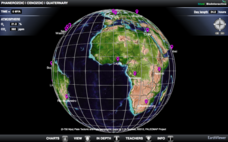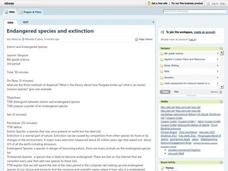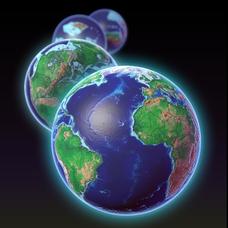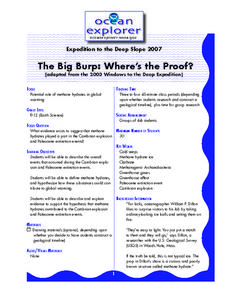Howard Hughes Medical Institute
Mass Extinctions Interactive
Extinctions constantly occur, but what sets off a mass extinction event? Young scientists study the data from the previous five mass extinctions to better understand their causes. Then, they learn the impact each extinction had on our...
Howard Hughes Medical Institute
Weighing the Evidence for a Mass Extinction: Part 1 – In the Ocean
Extinction events have happen throughout geologic history, but only five mass extinctions occurred over the last 4.5 billion years. Scholars view fossils from a layer of sediment during an extinction event and observe patterns to draw...
It's About Time
Mass Extinction and Fossil Records
The focus of a fossil-based lesson uses graphs and charts that allow young paleontologists to make inferences about events of mass extinction. They must apply their previous knowledge about fossil records in this final lesson of the...
Howard Hughes Medical Institute
Weighing the Evidence for a Mass Extinction Part 2: On Land
What can fossils tell us about periods of extinction? Young scholars interpret fossil layers to make conclusions about changes in life during different geological time periods. They analyze the fossils for abundance and diversity as well...
Howard Hughes Medical Institute
The Day the Mesozoic Died
While this is not the traditional, step-by-step lesson plan, it is chock-full of material that you can easily incorporate into your earth history unit. Its main purpose is to serve as a guide to using a three-part film, The Day the...
NOAA
Climate Is Our Friend…Isn’t It?: Make an Extinction Polyhedron
Climate affects populations in different ways. Scholars research extinct organisms and mass extinctions in part three of the 10-installment Discover Your Changing World series. They create graphic organizers, then fill in the information...
Curated OER
ARE WE IN THE MIDDLE OF A MASS EXTINCTION?
Students identify and interpret the following: What is mass extinction, and what are some theories for why it happens? How often do species become extinct? What is the normal rate of extinction? Why are some species endangered? What...
Howard Hughes Medical Institute
EarthViewer
Almost complete annihilation of the plants and animals on the Earth has occurred at least five times in the past. Young scientists explore each of these events. They learn about the evidence and conclusions for each event and connect...
Howard Hughes Medical Institute
Finding the Crater
A mass extinction event caused by an impact usually leaves a crater. Scholars use data from 10 different sites around the world trying to determine where to look for the crater. They use data, listing the amount of various minerals to...
Curated OER
AP: Chapter 25: Phylogeny and Systematics
As a review or note taking guide, this resource wraps up a unit on the tree of life. Biology bigwigs define phylogeny and answer questions about the subsequent classification of organisms. The worksheet takes a straightforward and...
Curated OER
History of Life
In this history of life worksheet, students will explore how mass extinctions have occurred on Earth, the different periods of the geological time scale, and scientists' use of fossil records. Students will complete 3 fill in the blank...
Curated OER
Extinction Is Forever
Students observe models of two kinds of forests with low and high biodiversity. They observe and record the effects of habitat destruction or extinction rates. They also conduct research about mass extinction like that of the ancient...
Curated OER
Speciation and Genetic Drift Worksheet
Fifteen terms pertaining to speciation, extinction, and gene flow are to be matched to their definitions. This simple, easy-to-read instructional activity can be used as a pop quiz for your biology learners when studying natural...
Curated OER
Extinction Theories: Dinosaurs
Learners examine how scientist use evidence to create theories. In this problem solving lesson, students use evidence cards to determine their own theory about the extinction of dinosaurs. They will debate their theories based on the...
Curated OER
Endangered Species and Extinction
Eighth graders determine the difference between extinction and endangered species. Using the internet, they research one endangered species, identify its common and specific name, where it lives and what it eats. To end the lesson,...
Curated OER
Scientific Inquiry
Sixth graders research the theories on the extinction of the dinosaurs. For this dinosaur extinction lesson, 6th graders view a video clip about scientific inquiry. They work in groups to research the two theories on dinosaur extinction.
Howard Hughes Medical Institute
Calculating Iridium Fallout from an Asteroid Impact
Should we be afraid of a large asteroid impact on Earth today? Young scientists estimate the size and composition of an asteroid similar to the one that caused the K-T mass extinction. They apply algebraic formulas to answer questions...
Curated OER
Estimating the Live Mass of Dinosaurs
Students estimate the live mass of dinosaurs. Using dinosaur and modern animal models, students use simple displacement methods to calculate the volume of the models. They calculate the masses of each model. Students compare the...
Howard Hughes Medical Institute
EarthViewer
Can you imagine Washington DC and London as close neighbors occupying the same continent? Learners will be fascinated as they step back in time and discover the evolution of the earth's continents and oceans from 4.5 billion years ago to...
Edinburgh UNESCO City of Literature Trust
The Lost World
Fans of Sherlock Holmes may be surprised to learn that in addition to stories of the famous deductionist, Sir Arthur Conan Doyle is also the creator of Professor Challenger. An irascible, unpredictable scientist, Challenger was featured...
American Museum of Natural History
Living Large
Get to know all about sauropods from a paleontologist, Jonah. Following an introductory video, scholars choose from five fossils to learn more about. Each fossil begins with a video, provides information from several different...
Curated OER
The Big Burp: Where's the Proof?
Students research the evidence for prehistorically formed methane hydrates contributing to global warming. In this climate change lesson plan, students work in groups to research methane hydrates, global warming, The Cambrian Explosion,...
Curated OER
Target Earth
Space scientists use water displacement to determine the mass of a cubic centimeter mini meteorite, and then use it as a small-scale representative of an asteroid. They figure out the orbital velocity of an asteroid. Then they use a...
Curated OER
Scientific Inquiry 3
In this instructional activity, 6th graders research and examine current theories behind the mass extinction of dinosaurs. After a discusion about the extinction of the dinosaurs, students discuss the two major extinction theories talked...

























